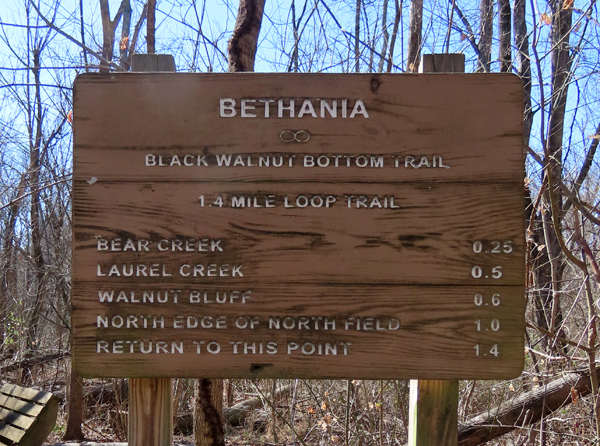Black Walnut Bottom

Black Walnut Bottom and Walnut Bluffs are two of several conservation properties along Muddy Creek have been acquired through cooperative efforts of the Town of Bethania, Piedmont Land Conservancy, Conservation Fund of Arlington, Virginia and the State of North Carolina. These properties now are owned by the State, and ASFC is assisting Bethania with management of these properties. The chapter has planted native plants along the edge of the parking area and has removed a large section of invasive multiflora rose from the woods.

Photo by Paul Nielson
Black Walnut Bottom consists of 35 acres of bottomland forest and fields on the Muddy Creek floodplain. Walnut Bluffs is an adjacent 20 acres of forested land above Laurel Creek. A trail starts at the Bethania Visitor Center at the intersection of Bethania and Bethania-Rural Hall Roads in the center of town. From Silas Creek Pkwy. and Reynolda Rd., take Reynolda Road west to the traffic signal at Bethania Road and turn right.
The trail begins in a wooded area that is good for woodpeckers, nuthatches, towhees and sparrows. Red-shouldered Hawk frequently are seen or heard near the creek, and Pileated Woodpecker also are possible either here or further along on the bluff. After about ? mile, the trail crosses a bridge and skirts the edge of a private farm. Especially in fall, this area is a good place to find sparrows and migrating warblers. After you cross the next foot bridge, you have a choice of routes. If you turn left, you can follow a hedge row that harbors migrants in spring and fall, Indigo Bunting, Catbird, Thrasher, Eastern Phoebe, Blue Grosbeak, Common Yellowthroat, Field Sparrow and perhaps Yellow-breasted Chat in summer, and kinglets and numerous sparrows in winter. Follow the mowed path as it loops by the community garden and into the woods. You also can bird along the other side of the field. If you follow the trail into the woods, it skirts the base of Walnut Bluffs and returns along the back of the fields.
Restrooms are at the Visitor Center; bring bug repellant in summer.
Reuter Survey Trail

Photo by Paul Nielson
A 1.5-mile trail has been added to a second tract of property located on the west side of Muddy Creek and across Bethania-Rural Hall Road. Park in the side lot of Logan Air Conditioning at the intersection of Bethania-Hall Rd. and North Causeway Blvd. Cross Bethania-Rural Hall Rd. and find the trailhead marker about 70 yards to your right. Be careful walking along the road.
This trail might be considered moderate, as it has some short hill climbs of 0.1 – 0.2 miles in length. However, the trail is well marked with names area names and distances. A short way into the woods, the trail turns left at a stone plaque and gradually ascends Bethania Knoll. At the 0.2 mile mark, there is a T-intersection. The main trail turns left, while a spur to the right takes you to the crest of the knoll. There you can rest on a bench before returning to the main trail. The knoll area is a good place to listen for Pine Warbler, Ovenbird and Norther Parula even into summer, along with other migrants songbirds in season.
Return to the main trail and follow it down hill. At the bottom of the hill, the trail flattens out and turns to the right toward Muddy Creek. At a small bridge over a creek, you may find Common Yellowthroat or Acadian Flycatcher. Continue straight into the pine grove marked as the Reuter Old Fields. In the grove, listen and look for woodpeckers. At the far end of the grove, you will reach an open edge along Muddy Creek. In warm months, watch for Indigo Bunting and Eastern Phoebe. The main trail loops to the right and returns to the bridge. Note: the trail along the creek and the trail along the creek and around the loop has grass and weeds that likely will be wet during warm-weather mornings.
Before taking that loop, you may want to follow the trail along the creek to the left, which has some good open stream-side habitat. This spur curves right, and at another pine grove a small side trail leads up through the woods toward the Lake Hills subdivision. This hill can be another good spot for Ovenbird, and for Wood Thrush. Return to the main trail and take the loop back to the plank bridge, keeping an eye out for nesting Lousiana Waterthrush along the creek. As you retrace your steps back to the car, notice an old road about half way up the hill toward the knoll. This is a short way back to Bethania-Rural Hall Rd. and offers some early-successional habitat that may yield different species, such as towhee or catbird. Just before the road, jog to the left to a fence gate and you will find yourself directly opposite where you parked. You also can use this location as an alternative entrance to the trail, especially if you want to avoid climbing the knoll.